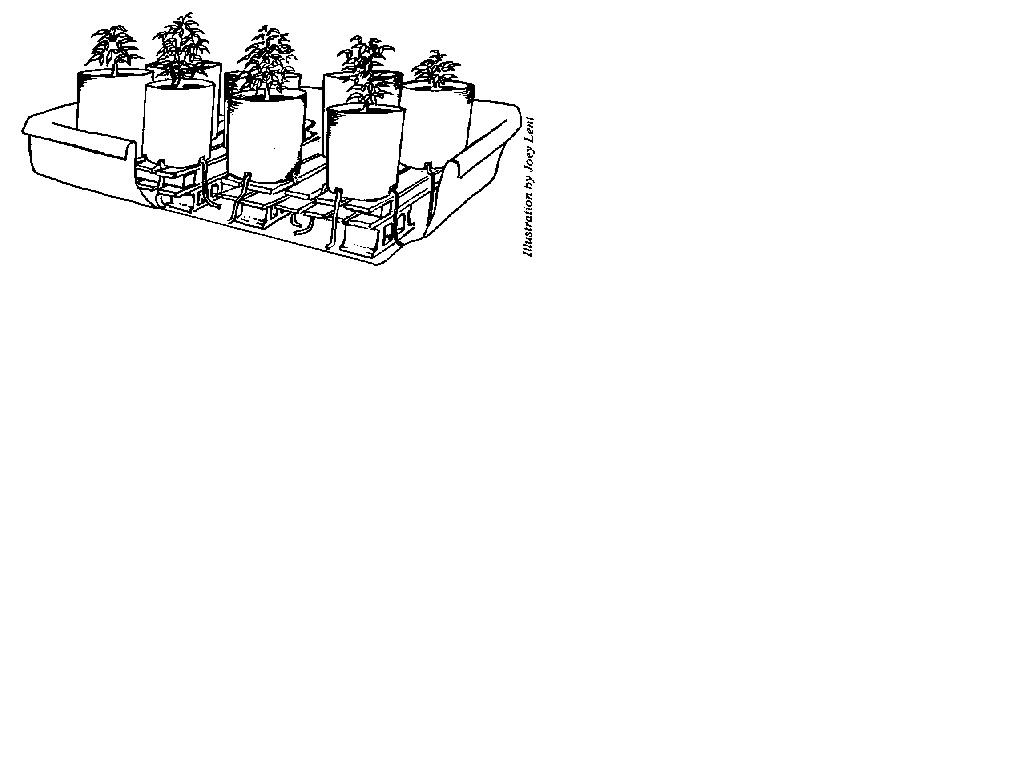
I have been growing plants for about six years, in the basement under mercury lamps (I should have used regular flourescent or HIDs), on my balcony, in the wilderness and finally in a closet at home. My results have been more and more encouraging as I learnt from previous mistakes.
I am very happy with my current indoors setup, especially after I found a solution to a problem that I've had for a long time. I am away from home quite regularly which always caused problems with watering. My favourite plant loves plenty of light and that also means it has a generous thirst for water without which it will wither and die. I usually had to water about every other day and for a very long time I had been looking for an alternative. However, I was worried about flooding my home and anything I used had to be reliable as well as easy to buy and build.
Growing dope with rope

I first came across the description of a wick system in Ed Rosenthal's "Marijuana Growers Handbook, Indoor/Greenhouse Edition" (ISBN: 0-932551-00-9, US$19.95), see illustration above, and recently decided to give it a try. A wick system feeds water to the planting soil the same way the wick of a candle will draw liquid wax into the flame. The idea is to provide a reservoir of water without depriving the plant's root system of oxygen by drowning it. As the roots absorb water, the drying soil will draw more water from the wick which in turn will draw more from the reservoir.
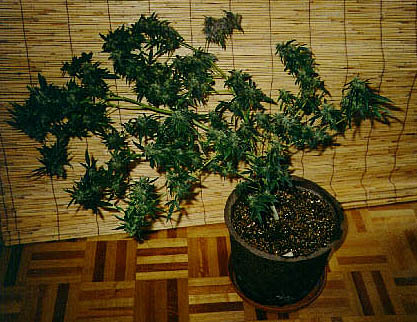
I first used a 12" (30 cm) pot and a similarly sized 2" (5 cm) high tray that I refilled as needed. The guide had suggested using nylon rope which won't rot, but since I only found other kinds of plastic rope and I was worried that they might be water repellant I went for 3/16" (5 mm) jute rope instead. Jute will rot slowly but should last through one growing season. If you buy synthetic rope, make sure it's real nylon!
I cut about half a dozen pieces of about 2' (60 cm) each, threaded them through the drainage holes at the bottom of the pot so that both ends would stand out far enough. The pot rests on some small pieces of lumber so only the wick will dip into the water while the drainage holes at the bottom of the pot will still admit air to the root-filled soil. I filled the bottom 2" (5cm) of the pot with vermiculite so that the wet rope would pass the water to the surrounding vermiculite which readily absorbs water. Above that I filled the pot with a well draining vermiculite / potting soil mixture.
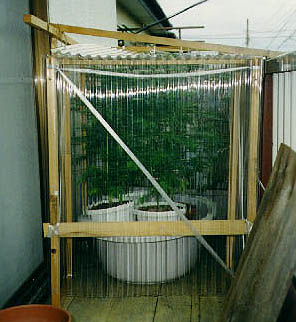 I
started the seeds in 6oz (0.2 L) paper cups, moved them to larger containers after a week
and then sexed them in the grow box along with my previous harvest unter 11 hours of
darkness. Only the females were then transplanted to large 12" (30 cm) pots kept on
my balcony. If I had started from clones I would not have had to sex them. The
wick-watered plants grew very well under the intense summer sun. When they were six weeks
old they became too large to hide on my balcony. This was just after I had harvested my
previous set of indoor plants, freeing up the grow room. Time to go indoors again for the
next harvest!
I
started the seeds in 6oz (0.2 L) paper cups, moved them to larger containers after a week
and then sexed them in the grow box along with my previous harvest unter 11 hours of
darkness. Only the females were then transplanted to large 12" (30 cm) pots kept on
my balcony. If I had started from clones I would not have had to sex them. The
wick-watered plants grew very well under the intense summer sun. When they were six weeks
old they became too large to hide on my balcony. This was just after I had harvested my
previous set of indoor plants, freeing up the grow room. Time to go indoors again for the
next harvest!
My wicked system
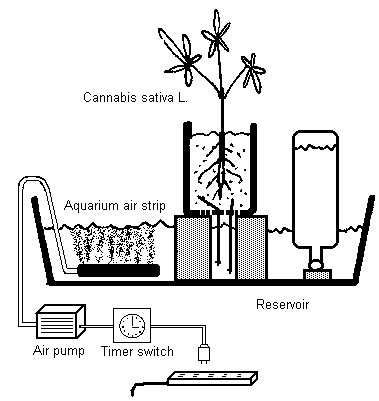
After the experiment with the trays showed that the plants would readily absorb enough water from the reservoir through the strands of rope left soaking in the water-filled tray, I switched to a larger heavy duty plastic container sold in a DIY shop for mixing concrete in. This reservoir was 36" x 18" x 8" (90 cm x 45 cm x 20 cm) and the pots sit on top of 2" (5 cm) high pieces of lumber, with only the rope reaching into the water so that the roots of the plants still receive enough oxygen.
Since a passive hydroponics system does not admit as much oxygen to the roots as an active one would (e.g. ebb & flow, drip feed), I use a small electrical air pump for aquariums hooked up to a bubbling strip (US$15) resting at the bottom of the reservoir to add oxygen to the reservoir water while the lights are on, to make sure the roots remain healthy. This means I can occasionally raise the water level to immerse the bottom of the planting pots to cope with particularly long periods of absence.
About once a month the pots are watered manually from the top, allowing the water to drain through the bottom. I then remove that water from the reservoir. This is to flush out any excessive buildup of nutrient salts in the soil, which is going to be a problem especially if the pots are small as in a sea-of-green type of operation. I usually add one film canister or less of 14-14-14 (N-P-K) chemical fertilizer to 5 gallons (18 L) of the water that I use to refill the reservoir with. During flowering a fertilizer more rich in P should be used.
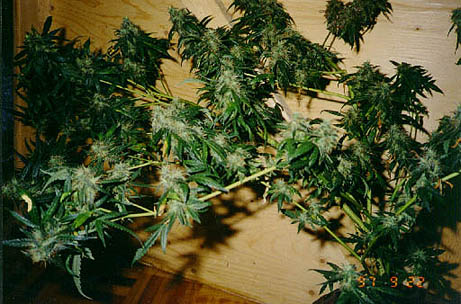
Two large plants grow in pots 12" (30 cm) in diameter and 10" (25 cm) tall. The growing tops have been clipped to create several large branches. The branches were spread around and tied down using jute string and wire so they grow horizontally. That's how I can grow a plant with a 3' (90 cm) main stem in a space that (allowing for pots and lamps) has only 18" (45 cm) of vertical clearance. I use short twists of wire to keep branches level and horizontal so they won't get burnt by the lamps. The branches fill the entire horizontal space of the grow room, extending beyond the reservoir.
The plants will absorb about 3 quarts (2.8 L) of water a day, causing the water level to fall by about 3/8" (1 cm) a day if it isn't replenished. I can refill the reservoir to 2" (5 cm) with 3 1/2 gallons (14 L) of water every five days, or starting with a water level of 3" I can go without watering for a week. What's more, I can extend that to two weeks by simply placing a couple of water-filled 2 quart (2 l) PET bottles upside down into the reservoir, resting their necks on small pieces of wood to prevent them from sliding. When the water level drops low enough to admit air into the necks of the bottles they will release a little water to keep the reservoir topped up. There are many other ways of automating the reservoir using gravity feed or pumps. The PET bottles however are simple and the height of the reservoir prevents flooding even if all water was released prematurely.
You can make a wristband like this from the stems of these plants:

In the future I will try to build an ebb-and-flow system, but this wick system has a simplicity that makes it usable even outdoors where no electrical power is available.
Happy growing! :-)